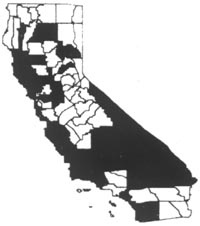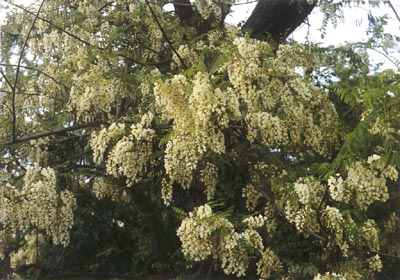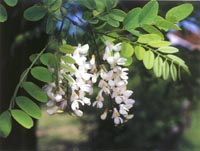|
Robinia pseudoacacia
|
|
|
|
Scientific name
|
Robinia pseudoacacia
|
|
Additional name information:
|
L.
|
|
Common name
|
black locust
|
|
Synonymous scientific names
|
none known
|
|
Closely related California natives
|
1
|
|
Closely related California non-natives:
|
0
|
|
By:
|
John Hunter
|
|
Distribution
|
|
|
HOW DO I RECOGNIZE IT?
Distinctive features:
|
Black locust (Robinia pseudoacacia)
is a tree that grows up to 100 feet tall. Its dark brown bark is very rough and
has interlaced ridges. The dark green leaflets are smooth, and the margins lack
teeth or serrations (entire), forming pinnate leaves eight to fourteen inches
long. Leaflets have short, slender spines at the base. The fragrant,
cream-colored, pea-like flowers are in elongate drooping clusters. The fruit is
a flattened brownish pod two to four inches long, each containing four to eight
seeds. Black locust differs from the native New Mexican locust (Robinia
neo-mexicana) in the absence of hairs on leaves, flowers, and
fruits.
åÊ
|
|
Description:
|
| Fabaceae. Deciduous tree 30-100 ft (10-30 m). Bark: brownish, thick, and furrowed, with forked ridges. Branches lack a terminal bud; generally have stipular spines alongside leaf scars. Leaves: alternate, odd-pinnate, once-compound, with 7-19 leaflets. Leaflets entire, elliptic to oval, and at the tip either rounded or truncate with a short spiny point. Inflorescences: pendant racemes borne in leaf axils of current yearÛªs growth. Flowers: generally whitish, |
|
Fruit: flat dehiscent pod with narrow wing
and 4-10 seeds. Seeds dark brown to black, 0.15 to 0.25 in (0.4-0.6 cm) long
(description based on Bailey 1949, Harlow et al. 1979, Huntley 1990, and Hickman
1993).
åÊ
|
|
WHERE WOULD I FIND IT?
|
Black locust is widespread, particularly in
northern California, below about 6,300 feet (1,910 m) elevation (Hickman 1993).
It is also common in the Great Basin area. It can grow on a wide range of sites,
but grows best on rich, moist, limestone-derived soils. It does not do well on
heavy or poorly drained soils, although it appears to be tolerant of some
flooding (Huston and Smith 1987, Huntley 1990). In the northeast United States
it is found on floodplain sites with a 40 to 100 percent probability of flooding
in any given year. Acceptable soil pH ranges from 4.6 to 8.2 (Huston and Smith
1987). Vogel (1981) reported the lower pH limit for black locust growth as 4.0.
It does not tolerate shade, but otherwise occurs in many habitats, particularly
on heavily disturbed lands such as roadsides and in stream bottoms and ravines.
It is found in disturbed woodlands and ravines in Tahoe National Forest and John
Muir National Monument.
åÊ
|
|
WHERE DID IT COME FROM AND HOW IS IT SPREAD?
|
Black locust is native to eastern North
America from Pennsylvania and southern Indiana south to Georgia and Louisiana
and west to Iowa, Missouri, and Oklahoma (Huntley 1990). The species has several
desirable traits that led to its cultivation: showy fragrant flowers, strong
rot-resistant wood, and nitrogen-fixing root nodules. Because of these traits,
it was planted widely beyond its original range and has become naturalized
throughout the United States and southern Canada (Huntley 1990). It was probably
brought to California by the gold-rush era settlers, although it is not included
in lists of early introductions (Jepson 1911, Frenkel 1970). It spreads by seed
dispersal (by gravity and wind) and by root sprouts.
åÊ
|
|
WHAT PROBLEMS DOES IT CAUSE?
|
Through root sprouts and seedling
establishment, black locust creates large stands that displace native
vegetation. Its seeds, leaves, and bark are toxic to humans and livestock
(Hickman 1993).
åÊ
|
|
HOW DOES IT GROW AND REPRODUCE?
|
Black locust reproduces both by seed and by root sprouts. It flowers in May-June. Fruits ripen in fall and open on the tree, dispersing seeds throughout fall and winter (Olson 1974). Seeds remain viable for ten years or more and require scarification for germination (Olson 1974, Strode 1977). Seedlings are intolerant of shade and herbaceous competition, but, once established, they are capable of growing over 3.3 feet (1 m) per year on
better sites (Huntley 1990). Saplings begin producing seed at about six years. The best seed production occurs between fifteen and forty years of age. Seed production continues until about age sixty. Heavier seed crops are produced at one- to two-year intervals (Olson 1974, Huntley 1990).
|
Black locust leafs out in late spring, and shoots elongate rapidly. Trees reach mature heights in twenty to forty years (Vines 1960), but are short-lived. Decadence may begin at forty years of age, and trees rarely live more than 100 years (Strode 1977, Collingwood 1937).
|
(click on photos to view larger image)
|
Black locust produces root and stump
sprouts. Sprout production is stimulated by top damage. Root suckers usually are
more important to reproduction than are seedlings. Root suckers first appear
when stems are four to five years old. Sprout production is greatest in full sun
(Huntley 1990). Sprouting is an important mechanism for colonizing areas that
have herbaceous plant cover but no woody canopy. Grasses form a sod that
prevents establishment of black locust seedlings, but root sprouts are able to
colonize these areas (Hardt and Forman 1989).
åÊ
|
|
HOW CAN I GET RID OF IT?
|
If mechanical or chemical control is
attempted, sites should be monitored at least twice each growing season. New
root sprouts should be removed, and monitoring should be continued for one year
after the last sprout is removed. Because there is also a dormant seedbank,
sites should be checked for new saplings at least every other year for ten
years.
åÊ
|
|
Physical control:
|
Mechanical methods: Cutting or girdling a
black locust stem will result in prolific root suckering. Mechanical removal
therefore will be ineffective in controlling black locust unless all stems are
cut several times per year. Repeated cutting of sprouts can kill the tree.
Cutting probably will need to be repeated for several years. Mowing may not be
effective in controlling seedlings and sprouts. More effective control can be
obtained by immediately brushing the freshly cut surface of the stem with
herbicide.
Prescribed burning: Burning has not been effective in
controlling black locust. Fire may kill main stems, but this will result in
prolific sprouting. Fire also may stimulate seed germination and create
favorable conditions for seedling establishment.
åÊ
|
|
Biological control:
|
Black locust suffers considerable damage
from insects, particularly the black locust borer, Megacylline robinine.
However, no USDA biological control program for black locust has been attempted,
and no USDA approved biocontrol agents exist for this species. Black locust
suffers some browse herbivory, particularly the young growth of sprouts, which
may aid eradication efforts (Huntley 1990, Luken 1992).
åÊ
|
|
Chemical control:
|
Black locust has been effectively
controlled with herbicides (Gouin 1979, Liegel et al. 1984, Scheerer and Jackson
1989, Smith 1993). Herbicide applications should be most effective in spring,
just after leaves are fully expanded. Smaller sprouts may be controlled by
spraying all foliage with 4 percent glyphosate (Chemical & Pharmaceutical
Press 1997). Young stems may be killed by generously applying 15-20 percent
triclopyr (as Garlonå¨) to the bark from the stem base to twenty inches above the
ground (Gouin 1979, Chemical & Pharmaceutical Press 1997). The thicker bark
of larger stems interferes with uptake of herbicide, and therefore, to kill
larger plants, the stem needs to be frilled (have an encircling ring of bark
removed) and the herbicide applied to the freshly exposed surface.
Applying herbicide to freshly cut stumps is probably the most
effective means of controlling black locust. Wiping the stump with 100 percent
glyphosate (as Roundup Ultraå¨) within fifteen minutes of cutting should reduce
or even eliminate subsequent root suckering (Chemical & Pharmaceutical Press
1997).
åÊ
|




